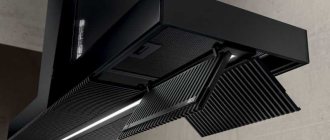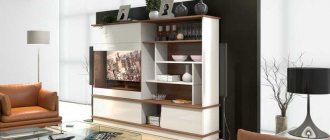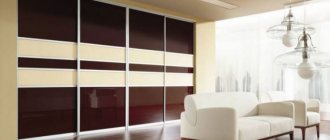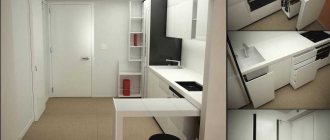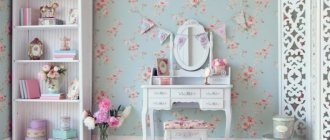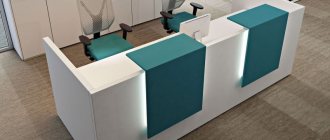What is the best way to place the TV?
Speaking about placing a TV in the living room, it is worth remembering that many apartments have undergone redevelopment and in this case the TV can be located on the wall in the hallway or in the kitchen.
A photo of a TV in the hallway usually surprises, but this is only due to the combination of two spaces in one apartment.
Based on the functions the living room performs, it is worth placing the TV in the space of the room. And also take into account the wishes of housewives and all household members. After all, for some it is important to watch the news in the morning with a cup of coffee, for others it is important to watch any TV series while preparing dinner for the whole family.
And these options can hardly be combined with an evening watching movies with the whole family. Therefore, in certain cases it is worth considering placing two TVs at once, one small in the dining area and a large one in a group with armchairs and a sofa for a large company.
When choosing a TV, it is worth remembering the size of the entire room. At what height should I install the TV in the living room? The larger the diagonal, the more space there should be in the hall.
If a large TV is placed too close to the sofa, then viewing will immediately become uncomfortable and even harmful to vision.
Therefore, you should take a sensible look at the dimensions of the room and choose equipment in accordance with them, keeping in mind the height of the TV in the living room.
It is ideal to choose the color of the TV in accordance with the overall design of the room. Today, the choice of technology is so great that black TV screens have become just one of the options.
In bright rooms in Provence or country style, it is better to use the white option, and in classic interiors, framing it with a baguette, which will create the illusion of a picture in a frame, is a worthy solution.
Traditional eastern wisdom also has its place. So, according to Feng Shui, you can pay attention to the pressing issues in the family and choose a place for the TV according to these criteria.
Small living room - the best decor ideas, design features and rules for decorating small living rooms (video and 165 photos)- Paintings for the living room: beautiful and modern trends in the placement of paintings (135 photos and videos)
Carpet for the living room - 165 photos and videos of expert advice on choosing and using carpets and coverings
If the relationship between spouses is suffering, hang the TV in the southeast; if you want to improve your financial condition, hang it in the southwest.
Racks
Television stands, which can be equipped with shelves and surfaces for additional equipment, look elegant and light in the living room interior. This holder is also convenient because it allows you to hide all the wires in the cable channel. Compactness and various shapes make it possible to use such a stand in a small living room, where every square meter is taken into account by the owners.
They have racks and a lot of other advantages that have allowed them to become a popular and modern furniture element:
- Large selection of models from various materials. This helps to choose a universal option for each buyer;
- Easy to install. No tools are required to install the stand and secure the TV in it, covering the wires and connectors;
- Height adjustment. You can fix the panel at a convenient level, depending on the height of the upholstered furniture;
- Possibility to move to another location. Some models are equipped with wheels, allowing you to install the stand in a place convenient for the owners;
- Additional shelves. Not available for all models. Each buyer himself thinks over the functionality of the rack and decides whether to purchase a sample with shelves or not;
- Ability to change the angle of rotation to the desired degree;
- Reliable fastenings designed for heavy loads;
- Ensuring proper operation of the TV;
- Durability and maximum aesthetics.
Types of racks
There are no universal designs. And when choosing a rack for a specific living room, you usually need to decide which option to prefer: wall-mounted or floor-mounted. In the first case, we get space savings and a static mount; it will no longer be possible to rotate or move the TV in height. Floor stands are more practical, but you will have to find a place for them.
Why do strawberry leaves turn red? What to do if strawberry leaves turn red?
Based on their design features, the following types of racks can be distinguished:
- Mounted with a rotating mechanism. It is characterized by a special panel that rotates around a support. Having moved in the living room, you can change the angle of rotation of the frame with the TV;
- Floor-standing with roller wheels. This design can easily change its location at the request of the homeowner. Typically, such racks are not equipped with rotating mechanisms;
- Tabletop. A convenient option for a small room. Allows you to place the TV on the table when there is a shortage of space;
- Stand with bracket. Helps to change the level of installation of the TV as needed to the desired height.
There are interesting design models in the form of separate legs, easels, glass desks, tables, made in various versions. Racks are made of metal, wood, and combined models contain glass. The holders themselves are made of durable aluminum.
Tips for choosing a stand
When purchasing this type of TV furniture, pay attention to the following aspects:
- Combination with the design concept of the room. It is unlikely that such a structure made of stainless steel with a metallic coating and tempered dark glass would be appropriate in a living room designed in the Baroque or Empire style;
- Safe to use. It is also worth finding out about the maximum load that the planes and the TV holder itself can bear. It is better to opt for shelves made of tempered glass with a thickness of at least 6 mm with a safe edge. If there are children in the family, then you need to think about the most sustainable model;
- Combination with a specific TV and other equipment. You need to find out about this from the sellers in the store, whether the option you like is suitable for your equipment. If you have additional devices, it will be more convenient to have a rack with cable channels that will help hide many wires.
Placement under stairs
A story that is only suitable for large two-level apartments or private houses. In this case, the decision to place the TV under the stairs will be ideal and ergonomic.
A niche under the stairs will hide the TV from the walkway and create an entire area dedicated to watching movies.
Types of TV walls with photos
Modular walls
All items can be purchased as a set at once, or you can select them yourself. The latter is possible if the furniture consists of separate modules. Headsets composed of different modules with strict outlines look very modern.
The beauty of this idea is that you can hang them on the wall or place them on the floor as you wish - the design of the room will not be affected, and the composition will be pleasing to the eye. In addition, cabinets and cabinets are multifunctional. For example, pull-out cabinets are suitable for seating or use as a coffee table.
Photo: Instagram uyut_shkaf
Photo: Instagram uyut_shkaf
Photo: Instagram uyut_shkaf
Hull walls
In this case, you won’t be able to buy additional cabinets and shelves you like separately. Initially, the entire structure is securely fastened and fixed to the wall. This is a single system, the center of which is the TV and a niche for it. But there is still room for imagination to run wild: you can play with the asymmetry of shapes, the presence or absence of facades, and lighting. The latter also performs a utilitarian function if you decide to equip a desk in the transforming wall.
Placement in built-in furniture
The most popular option for Russian apartments. The TV becomes part of the furniture set, be it a massive oak wall or a light frame structure.
The TV fits perfectly into the proportion of the furniture and eliminates the chance of hitting or breaking the TV as you move in the room.
Classic interior
Such an interior requires consistency and regularity of lines, as well as an abundance of stucco, noble shades and high-quality furniture.
An ordinary television screen stands out greatly from a design project made in a classical style. There are a number of solutions:
- Hide the TV behind a screen;
- Built into a closet - a TV wall in the living room can be a good solution;
- Close with a sliding structure or cabinet door, simulating a chest of drawers or additional sections of a furniture set;
- Decorate the TV in a baguette or stucco molding.
Scandinavian style
The style is similar to classic, the TV does not fit very well with the simplicity and light colors of northern Europe. What to do? Everything should be as simple and realistic as possible in relation to the stylistic direction.
- Place on a cabinet or chest of drawers and add traditional Scandinavian decor;
- Close with curtain;
- Hide it in the closet.
How to choose a wall color
And let's return to color again, since this is one of the key points in creating a modern interior and selecting furniture. The main mantra to learn is simplicity and playing with contrast. Background colors are unpretentious, monochrome, often pale. But there is almost always one or more details in focus: they are bright, like flashes.
When choosing a wall, think about whether there are such details in your room? If so, then the TV set should not be another stain. It’s better if it’s there, but it’s as if it’s not there: it matches the color of the main interior, and even dissolves in it.
Photo: Instagram raisa__belkova
Photo: Instagram raisa__belkova
If there are no accents, you can safely highlight the TV zone. And it’s better in color: an excess of accessories does not suit the modern style.
You can play on the contrast by “contrasting” the furniture with the decoration of the walls and floor according to the dark-light principle. In dark rooms, light-colored furniture looks advantageous (only all of it should be like this, and not just the TV group); in light rooms, it’s the opposite. Following this principle, you will get closer to high-tech or minimalism.
Photo: Instagram lume_home
Photo: Instagram yard_khv
Loft style
The style is similar to modern. He welcomes any kind of emphasis on the presence of a television. It is ideal to place it on a voluminous wooden chest of drawers or to play with a harsh concrete stand and place it in a brick niche.
Natural materials combined with modern technologies are what you couldn’t imagine better for the loft style. A TV stand in a loft living room would look good.
In a minimalist interior, there is a simple rule - the thinner and more innovative the TV, the better. In a number of rooms, a TV will look beautiful against a brick wall, and this is not just a loft. This solution will give additional texture to the room.
If the choice fell on wallpaper, you should understand that the brighter the wallpaper, the more they distract from the picture. Choose simple, laconic options with a minimum of pattern or geometry so as not to distract attention.
An unusual solution could be laminate or wood panels. This is a beautiful texture and nobility that will make the room warm and homely.
TV wall: what to buy
Furniture for TV can be different. The simplest models can be purchased inexpensively in the mass market. This will be an open shelf with a compartment for small items, which, thanks to its laconic appearance, will fit into any interior.
There are other universal cabinets, but with several shelves. The length is approximately 0.9–1.2 m, and the height varies from 40 to 60 cm. More expensive models come with facades, cheaper ones without them.
Very often the bedside table is not alone, but comes complete with:
- dresser,
- cabinets (corner, “slides”),
- mini bar,
- sideboard,
- open shelves for souvenirs or books,
- closed shelves for things.
They usually have one thing in common - the TV is in the center, although not always. The rest depends on the place where the furniture is located and the taste of the owners.
TV stand
The most minimalist thing you can come up with is a panel with shelves, or without them at all. For some models, the height of the TV is adjustable, as well as its rotation around its axis to select the correct viewing angle.
Photo: Instagram kog_design
Photo: Instagram obrazform
Nightstand
Another compact option, but beloved by many, is a long rectangular cabinet, often without legs, hanging. The length and width of the product can be ordered to any size, taking into account the required capacity.
Photo: Instagram soulwood_furniture
Photo: Instagram soulwood_furniture
Photo: Instagram dliatebyamebel
Photo: Instagram fineobjects
There is no need to install a TV. It can be hung from above, and a strip of “air” between it and the cabinet will make the situation even easier.
Low legs will give the same effect: they will raise the structure, especially if the floor is smooth and there are also straight lines in other interior details.
The advantage of a simple cabinet is that it can be easily supplemented with shelves, pencil cases, and small cabinets over time. The variability of combinations is perfect for those who quickly get bored with monotony.
Chest of drawers
An “extended” version of a strict cabinet - with drawers, and sometimes without any special design refinements. It can even be an ordinary chest of drawers for things - the main thing is that it can withstand the weight of the TV. Such a decision, seemingly from the day before yesterday, sometimes looks very harmonious.
Photo: Instagram mebel_style_su
Photo: Instagram mebel2735733
Photo: Instagram mebel_style_su
Corner furniture
Such walls are often a cabinet or modular combination of several cabinets (designed, among other things, for speakers and amplifiers), shelves, chests of drawers, and bedside tables.
In general, it is good to design any TV group in a corner, especially if it is free. Corner furniture is very helpful in small rooms: it is spacious, you can put almost any size cabinet or hang any shelves, and at the same time the design will definitely not clutter up the room, and you will not bump into ledges.
The fronts of the cabinets can be made glazed, and this way they will appear open, but dust will not settle on things; Or you can use mirrored ones to visually increase the area of the room.
"Slide"
It got its name due to the gradual increase in height. It has been known for several decades, only in Soviet times, of course, it had a completely different design. Back then it was bulky furniture in every sense, which is now suitable only as a retro highlight in some interiors.
Modern slides are lighter, more concise, yet they are spacious and suitable even for a small apartment. Due to the combination of closed, open, glazed shelves they look interesting and do not “press”.
The slide wall can be straight, L-shaped or U-shaped.
Cabinets
Next to the TV, apartment owners place both the usual wardrobes and models that impress with their bizarre curves. Their purpose is no different from ordinary cabinets: they are used for clothes, dishes or other things.
Photo: Instagram intercasa_2011
Photo: Instagram _smart_mebel
If space allows, then a large wall or a wardrobe around the TV is quite acceptable. But keep in mind that such furniture is best suited for square rooms: it will make an already elongated rectangle visually even longer, and you may not like the finished look.
If you make a custom-made wardrobe, it is easier to take into account the features of your home. It can become one with the entire room, adding light and holding as many things as you need.
Very often, cabinets and TV stands are a single combination. To prevent this harmony from being disturbed, manufacturers decorate the wall behind the TV with a large panel to match the cabinets. This creates a visually monolithic TV group.
The walls can be made in one color, or in two similar or contrasting shades.
Photo: Instagram mebital.ua
Photo: Instagram mebital.ua
Mini bar
And this is a very convenient solution for the living room or kitchen-living room, where there is a relaxation area. The bar is usually made not under the TV, but in a nearby cabinet.
Photo: Instagram trio_interior
Photo: Instagram intercasa_2011
Shelves
The space next to the TV is decorated with shelves - open or closed. The former may look more interesting due to their unusual design and decor.
Photo: Instagram polkasota
Photo: Instagram polkasota
How to decorate the space next to the TV?
It's simple. Small decor will do. It would be ideal to place a vase of flowers or a composition of candles on the cabinet next to it, not forgetting about safety precautions. Small figurines or photographs would also be nice.
Pictures are a more complex option; they are a way to disguise the TV as a picture and make it part of the composition; on the other hand, they are a way to constantly be distracted from the film.
It is important not to miss the plot and colors. An equally popular option are shelves; options with staggered placement will look especially good.
Today, friends and acquaintances have quite a lot of living rooms without a TV. For some, a TV in the living room interior is a basic necessity, for others it is an unnecessary accessory. In any case, it is always important to think about the design of the TV in the living room, which will be pleasing to the eye!
Materials for TV walls
Tree
Of course, nothing better than wood has yet been invented. Durable, easy to use, has a respectable appearance, allowing you to play with shape and color. But at the same time, it’s not cheap.
For the walls, both valuable species are used (mahogany, rosewood, walnut, oak, beech) and more affordable alder, birch, and pine.
In addition to being expensive, wooden furniture has several other features:
- she's heavy
- afraid of high humidity,
- Does not tolerate high temperatures well.
Chipboard and MDF
These alternative materials are good as long as the manufacturer meets all quality standards. The price is much lower than for solid wood products, and there are more opportunities to create things with interesting shapes.
Chipboard is commonly used to make cabinet frames. It can emit formaldehyde, so it is carefully processed and covered with a film that imitates different types of wood surfaces. Despite the protection, it is not recommended to install chipboard furniture in children's rooms, or you need to request safety certificates from the seller.
It is better to choose facades from MDF, although they are more expensive than chipboard ones. Such furniture is environmentally friendly and is not much inferior in durability to wood. Like chipboard, MDF is made from sawdust, but no harmful resins are used for gluing.
Photo: Instagram sharapova_design
Photo: Instagram planirovochka_ru
There is also fiberboard (fibreboard) material in the walls - in the bottoms of drawers, on the back walls of cabinets, in panels for hanging a TV.
Manufacturers love to combine materials. Thus, the body is often made of chipboard, and the doors are hung wooden or with inserts made of glass, plastic, metal or plastic laminated with a textured film to resemble wood.
In the middle and high price segments you can find furniture with an MDF frame and wooden facades. It weighs less than a solid wood set, it is easier to care for, and there are no problems with durability.
Photo of TVs in the living room
Please repost

111111111





